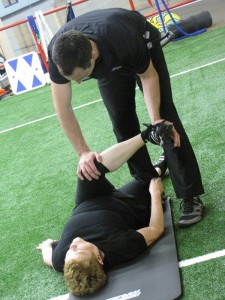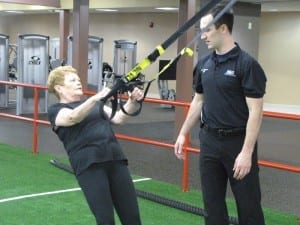
Sharon Doros, 69, has been a member at Newtown Athletic Club (NAC) for 34 years. “34 years is a long time — they have many 20-year and 30-year members,” said Doros. What’s NAC’s secret to retaining a number of its members for more than two decades? According to Doros, it’s the attention they pay to the member — “They’re totally customer friendly and wonderful,” she explained.
Joining in 1978, Doros has seen NAC evolve as a club and organization as one of the first members to join. Originally, NAC was a racquetball club and had very limited programming. Now, the club offers a variety of fitness options to its members.
According to Linda Mitchell, the director of marketing and public relations for NAC, one of the keys to the club retaining its members has been its ability to evolve as an organization. “We began as a 15-court racquetball club at 25,000 square feet,” said Mitchell. “We are now 120,000 square feet and have no racquetball courts left.We changed with the times. By keeping in touch with the trends through trade journals, fitness conventions and IHRSA, we implemented changes, renovations and expansions over the years, which allowed us to better serve our market.”
For Doros, those changes appealed to her as a member. Since NAC’s inception, she now has more resources available to her to better her fitness than ever before. “I guess the absolute best thing about NAC is it has very diverse programming,” said Doros. “There are so many programs available to you, like Pilates, Zumba, strength training — everything that you could possibly need to have. As the club has grown I’ve been able to take advantage of all the programs that have grown with it.”
In April of 2009, Doros was forced to take advantage of NAC’s personal training services after she was involved in a car accident that left her with a frozen shoulder, knee and back injuries. Her insurance had stopped paying for physical therapy, so she signed up for physical rehabilitation with Jeff Ritter, who at the time was a personal trainer at NAC.
Ritter, now the fitness director at NAC, explained how functional fitness was the leading factor to Doros’ injury rehabilitation. “When she came to me we picked up where she had left off with physical therapy,” said Ritter.

However, where physical therapy through Doros’ insurance plan differed from training with Ritter, was the emphasis that Ritter placed on her entire body’s overall fitness — not just the rehabilitation of her injuries. “We don’t just train one body part. Everything we did was based around total-body movements, because that’s how it works in real life.”
With her knee being the biggest issue, Ritter started her off on the leg press. “When she just started out the leg press made sense for her right away,” explained Ritter. “After she progressed, we moved on from there. We started doing more functional movements, such as a one-legged lunge with the TRX strap that was more functional. We did a lot of movements that were more functionally-based that taught her how to move correctly and would carry over into her everyday life,” he said.
According to Ritter, working with older clients can pose some challenges. “At [Sharon’s] age, they have to realize that it’s going to hurt but it’s going to be worth it in the long run,” said Ritter. With Doros, that wasn’t an issue. “If I told her to do something she worked through the pain and stuck with it.”
After working with Ritter for months, Doros was able to make a full recovery. “It was due to [Jeff] I was able to complete my rehabilitation,” said Doros. “I give him and the NAC all the credibility. It wasn’t easy, but my knee is functional and I’m able to do just about whatever I want with it now.”
In the end, it was the attention and care that NAC gave to Doros that led to her success and her long-time commitment to being a member. “They’re very, very member-oriented,” she said. “They always have been. They want to make sure you want to continue there.” Whatever NAC is doing, it’s working. Doros plans to continue working out at NAC as long as she can.
What does your club do to work at retaining members? Do you offer diverse programming? Ritter suggested that clubs advise personal trainers to receive specific certifications, such as kinesiology or corrective exercise. Doing so will continually better your staff, and up the chances that members use your services instead of going elsewhere.
By Rachel Zabonick
Stay ahead in the fitness industry with exclusive updates!
Rachel Zabonick-Chonko is the editor-in-chief of Club Solutions Magazine. She can be reached at rachel@peakemedia.com.












Thank you for writing this article, Rachel. It is a terrific testament to Sharon and her dedication and strong will. She was reluctant to be featured, but her devotion to Jeff and her unwavering belief that exercise and fitness have saved her life and mobility drove her to share her story with others.